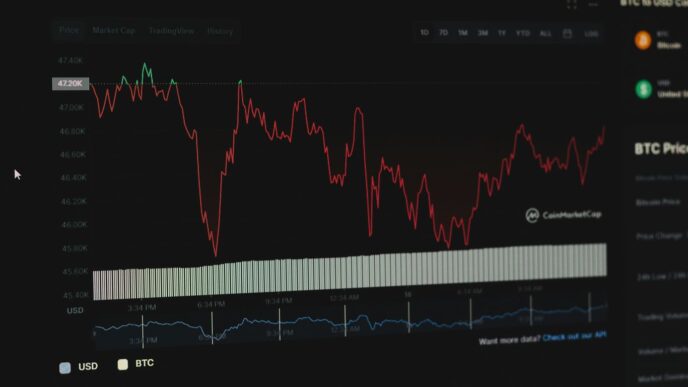Getting your small business noticed in 2025 means you need good marketing. It’s not always easy, especially when you don’t have a huge budget like bigger companies. But don’t worry, you don’t need tons of money to get great results! This article will go over some smart marketing strategies for small businesses that can help you grow and connect with more customers this year. Let’s get into it!
Key Takeaways
- Use smart tech like AI to make your work easier and reach customers better.
- Focus on your local area and get involved with the community.
- Tell your business’s story clearly to build a strong brand.
- Make short, interesting videos to grab people’s attention.
- Look at your marketing numbers to make good decisions.
Leverage AI and Automation Tools for Enhanced Efficiency
Okay, so, 2025 is here, and if you’re still doing everything manually, you’re probably wasting a ton of time. AI and automation aren’t just buzzwords anymore; they’re actual tools that can seriously help small businesses get more done with less effort. Think about it – less time on boring tasks means more time focusing on the stuff that actually grows your business. Let’s get into how you can make this happen.
Streamlining Content Creation with AI
Content is king, right? But creating it can be a real drag. Luckily, AI can help. AI-powered tools can generate blog posts, social media updates, and even email copy in a fraction of the time it would take a human. I’ve been playing around with a few, and while they’re not perfect, they’re a great starting point. You can then tweak and refine the content to match your brand’s voice. It’s like having a robot assistant who can handle the first draft, freeing you up to focus on strategy and creativity. Plus, AI can help with AI-driven marketing by analyzing trends and suggesting topics that will resonate with your audience.
Automating Customer Relationship Management
CRM systems are nothing new, but AI takes them to the next level. Instead of just storing customer data, AI can analyze it to predict customer behavior, personalize interactions, and automate follow-ups. Imagine a system that automatically sends a personalized email to a customer after they abandon their shopping cart, or one that suggests relevant products based on their past purchases. That’s the power of AI-driven CRM. It’s all about making your customers feel seen and understood, which leads to increased loyalty and sales. You can use marketing automation tools to manage these repetitive tasks.
Personalizing Marketing Campaigns with AI Insights
Generic marketing is dead. People want to feel like you’re talking directly to them. AI can help you achieve this by analyzing vast amounts of data to identify patterns and segment your audience. This allows you to create highly targeted campaigns that resonate with specific groups of people. For example, if you’re running an ad campaign, AI can help you identify the demographics, interests, and behaviors of your ideal customer, allowing you to target your ads more effectively. This leads to higher conversion rates and a better return on investment. It’s about using data to make smarter decisions and create more meaningful connections with your audience. This is a key part of any small business marketing strategy.
Mastering Local SEO and Community Engagement
Okay, so you’ve got a business. Great! But does your local community even know you exist? That’s where mastering local SEO and really getting involved with your community comes in. It’s not just about ranking high on Google (though that helps!), it’s about becoming a real part of the neighborhood. Think of it as making friends, but with a business card.
Optimizing Google My Business Profiles
Your Google My Business (GMB) profile is like your digital storefront. It’s often the first thing people see when they search for your business, so you want to make a good impression. Make sure all the information is correct – address, phone number, hours. And don’t forget photos! High-quality photos of your business, your team, and your products can really make a difference.
- Regularly update your profile with posts about promotions, events, or just general news. Think of it as your mini-social media feed right on Google.
- Respond to reviews, both good and bad. It shows you care about what your customers think.
- Use relevant keywords in your business description to help people find you when they’re searching for specific products or services.
Building Local Citations and Backlinks
Think of citations as mentions of your business online. The more consistent mentions you have across different websites, the more Google trusts that your business is legitimate. Backlinks are links from other websites to yours. Getting backlinks from reputable local websites can really boost your SEO.
- List your business in online directories like Yelp, Yellow Pages, and industry-specific directories.
- Reach out to local bloggers or news outlets and see if they’d be willing to write about your business.
- Participate in local events and ask the organizers to link to your website from their event page.
Fostering Community Connections Offline and Online
Being a part of the community is about more than just selling products or services. It’s about building relationships and giving back. When people feel connected to your business, they’re more likely to become loyal customers.
- Sponsor a local sports team or charity event. It’s a great way to get your name out there and support a good cause.
- Host workshops or events at your business. This can be anything from a cooking class to a networking event.
- Engage with your community on social media. Share local news, support other local businesses, and participate in conversations. Geo-targeted ads can help with local engagement and boost sales.
Crafting a Compelling Brand Narrative

It’s easy to overlook the power of a good story, but in 2025, it’s more important than ever. People aren’t just buying products or services; they’re buying into brands they believe in. Let’s talk about how to make your brand one of those.
Defining Your Unique Value Proposition
What makes you different? Seriously, dig deep. It’s not enough to say you have great customer service (though that’s important). What specific problem do you solve better than anyone else? What’s your angle? Think about what you bring to the table that no one else can. This is your unique selling proposition, and it needs to be crystal clear.
Consider these questions:
- What are the key benefits customers get from your product/service?
- What makes your business different from competitors?
- What specific problem do you solve for your customers?
Storytelling to Connect with Your Audience
Facts tell, but stories sell. People connect with narratives on an emotional level. Don’t just list features; tell a story about how your product or service has helped someone. Use case studies, customer testimonials, or even create fictional scenarios that resonate with your target audience. Authenticity is key here; don’t try to be something you’re not.
Building Brand Loyalty Through Consistent Messaging
Consistency is king. Your brand’s voice, visual identity, and values should be consistent across all platforms – your website, social media, email marketing, and even in-person interactions. This builds trust and makes your brand recognizable. Think of it like this: if your brand were a person, what would their personality be like? Make sure that personality shines through in everything you do. It’s about making sure your small business is always top of mind for potential customers.
Investing in Dynamic Video Content
Video is king, they say. And honestly, it’s still true in 2025. People just love watching stuff. It’s way easier than reading, right? So, if you’re not putting out videos, you’re missing out on a huge chunk of potential customers. It’s not just about having any video, though. It needs to be good. It needs to grab attention. It needs to be dynamic.
Creating Engaging Short-Form Videos
Okay, so everyone’s obsessed with short videos. TikTok, Instagram Reels, YouTube Shorts – they’re everywhere. These platforms are gold for small businesses. Why? Because you can get your message across super quick. Think bite-sized content. Show off your product, give a quick tip, or just be funny. The key is to keep it short and sweet. Nobody wants to watch a boring, long ad. Get to the point, make it visually appealing, and use trending sounds.
Utilizing Live Video for Real-Time Interaction
Live video is where it’s at for building a real connection. Think about it: you’re talking to people right now. You can answer their questions, get their feedback, and show them the real you. It’s way more personal than a pre-recorded video. You could do a Q&A, show off a new product, or even just give a behind-the-scenes look at your business. Just make sure you have a plan. Nobody wants to watch you fumble around for an hour. Promote your live video ahead of time, have some talking points ready, and be yourself.
Optimizing Video Content for Different Platforms
Don’t just make one video and post it everywhere. That’s lazy. Each platform is different, and your video needs to fit. What works on TikTok might not work on YouTube. Think about the aspect ratio, the length, and the audience. YouTube is great for longer, more in-depth videos. TikTok and Instagram Reels are all about short, attention-grabbing content. Facebook is somewhere in the middle. Tailor your video marketing to each platform, and you’ll get way better results. It takes a little extra effort, but it’s worth it.
Collaborating with Micro-Influencers
Micro-influencers are where it’s at in 2025. Forget shelling out big bucks for celebrity endorsements. These folks have smaller, but way more engaged audiences. Think of them as your friendly neighborhood experts. They’ve built trust, and that trust translates when they talk about your product.
Identifying Authentic Micro-Influencer Partnerships
Finding the right micro-influencer is like finding the perfect puzzle piece. You want someone whose values align with your brand. Don’t just look at follower count; look at engagement. Are people actually interacting with their content? Do they seem genuine? A good start is to use influencer marketing strategy tools to filter by niche, location, and engagement rate. Look for influencers who are already talking about topics related to your industry. It shows they’re genuinely interested, not just in it for the freebies.
Developing Mutually Beneficial Campaigns
It’s not just about what the influencer can do for you; it’s about what you can do for them. Think of it as a partnership, not a transaction. Offer them something of value, whether it’s early access to products, exclusive discounts for their followers, or even just creative control over the content. Clear communication is key. Outline your expectations, but also give them room to put their own spin on things. After all, their authenticity is what makes them effective. Here’s a few ideas:
- Content Collaboration: Have them co-create content with you.
- Affiliate Marketing: Give them a unique code to track sales.
- Sponsored Posts: Pay them to create content featuring your product.
Measuring the Impact of Influencer Collaborations
So, you’ve launched your campaign. Now what? You need to track your results. Don’t just look at likes and comments. Dig deeper. Are you seeing an increase in website traffic? Are people actually buying your product after seeing the influencer’s post? Use UTM parameters to track where your traffic is coming from. Monitor social media mentions to see what people are saying about your brand. And don’t be afraid to ask the influencer for their insights. They’re on the front lines, interacting with their audience every day. They can give you valuable feedback on what’s working and what’s not.
Implementing Data-Driven Marketing Strategies
Data-driven marketing isn’t just a buzzword; it’s how smart businesses operate now. It’s about using information to make better choices, plain and simple. No more guessing – just solid facts guiding your marketing efforts. The goal is to understand what works, what doesn’t, and why.
Analyzing Website Traffic and User Behavior
First things first, you need to know what’s happening on your website. Who’s visiting? What pages are they looking at? How long are they staying? Tools like Google Analytics are your best friends here. Look at bounce rates, time on page, and conversion paths. This data tells you where people are getting stuck or losing interest. For example, if a lot of people are leaving a specific product page quickly, maybe the description isn’t clear, or the images aren’t good enough. Understanding user behavior is the first step to improving their experience.
Tracking Campaign Performance Metrics
Running a marketing campaign without tracking results is like driving with your eyes closed. You need to know if your ads are working, if your emails are being opened, and if your social media posts are getting engagement. Key metrics include click-through rates (CTR), conversion rates, cost per acquisition (CPA), and return on ad spend (ROAS). Set up tracking from the start, and regularly review the data. If a campaign isn’t performing well, don’t be afraid to tweak it or even scrap it altogether. Here’s a simple example of how you might track campaign performance:
| Campaign | Clicks | Conversions | CPA |
|---|---|---|---|
| Adwords | 500 | 25 | $20 |
| 300 | 10 | $30 | |
| 1000 | 50 | $5 |
Making Informed Decisions Based on Analytics
All that data you’re collecting is useless if you don’t actually do anything with it. Use your analytics to make informed decisions about your marketing strategy. See a drop in website traffic? Investigate potential causes, like a broken link or a change in search engine rankings. Notice that a particular email subject line is getting a high open rate? Use similar subject lines in future campaigns. Data-driven decisions lead to better results and a more efficient use of your marketing budget. It’s about constantly testing, learning, and optimizing. Don’t be afraid to experiment with marketing strategies and see what works best for your audience.
Building a Robust Email Marketing Funnel
Email marketing? Still a big deal in 2025. It’s not just about sending out newsletters anymore. It’s about creating a whole system that guides potential customers from just hearing about you to becoming loyal fans. Think of it like a sales machine that works even when you’re sleeping. Let’s get into how to make it happen.
Growing Your Email Subscriber List Organically
Okay, so first things first, you need people to actually send emails to. Buying lists? Don’t even think about it. It’s a waste of money and will probably get you marked as spam. Instead, focus on getting people to sign up because they want to hear from you. Here are some ideas:
- Offer something cool in exchange for their email. Think a free e-book, a discount code, or access to exclusive content. People love free stuff.
- Make it super easy to sign up. Put signup forms on your website, your social media pages, and even in your store if you have one. The fewer clicks, the better.
- Run contests and giveaways. This is a great way to get a lot of emails quickly, but make sure the prize is something that your target audience actually wants. Promote your marketing automation tools to get more signups.
- Use pop-up forms on your website. But don’t be annoying! Make sure the pop-up only appears after someone has been on your site for a certain amount of time, or when they’re about to leave. No one likes being bombarded the second they land on a page.
Segmenting Your Audience for Targeted Messaging
Sending the same email to everyone on your list is like shouting into a crowd. Some people might hear you, but most will just tune you out. That’s why segmenting your audience is so important. It means dividing your subscribers into smaller groups based on things like their interests, their purchase history, or their location. This way, you can send them emails that are actually relevant to them. For example:
- New subscribers: Send them a welcome email series that introduces your brand and what you have to offer.
- Customers who have purchased a specific product: Send them emails about related products or special offers.
- Subscribers who haven’t opened an email in a while: Try sending them a re-engagement campaign with a special discount or offer.
Segmentation can seem like a lot of work, but it’s worth it. Targeted emails get way higher open rates and click-through rates, which means more sales for you. Consider using top marketing software to help with segmentation.
Crafting Engaging Email Campaigns and Newsletters
Okay, you’ve got your list, and you’ve segmented it. Now it’s time to actually write some emails. Here’s the thing: people’s inboxes are crowded. You need to make your emails stand out. Here’s how:
- Write catchy subject lines. This is the first (and sometimes only) thing people will see. Make it intriguing, but don’t be clickbaity. No one likes being tricked.
- Keep it short and sweet. People don’t have time to read long, rambling emails. Get to the point quickly and make it easy to scan.
- Use visuals. Images and videos can make your emails more engaging. Just don’t go overboard. You don’t want your email to look like a Christmas tree.
- Include a clear call to action. What do you want people to do after they read your email? Make it obvious. Use a button or a link that stands out.
- Test, test, test. Try different subject lines, different layouts, and different calls to action to see what works best for your audience. A/B testing is your friend. Track your email open rates to see what’s working.
Email marketing isn’t dead. It just needs a little love and attention. By building a robust email marketing funnel, you can turn casual subscribers into loyal customers and grow your business in the process.
Conclusion:
Getting your small business noticed in 2025 doesn’t have to cost a lot or be super hard. If you focus on building your brand online, using tools that don’t break the bank, and connecting with people in your area, you can really see your business grow. Just remember, doing things regularly and being a little creative are what really count! Ready to step up your marketing? Start now and watch your small business do great things!
Frequently Asked Questions
How can AI and automation help my small business?
AI and automation tools can help small businesses by making tasks like writing content or talking to customers much easier and faster. They can also help you send the right messages to the right people, making your marketing more effective.
What is local SEO and how do I do it?
Local SEO means making sure your business shows up when people in your area search for things online. You can do this by keeping your Google My Business page updated, getting mentions from other local places, and being active in your community, both online and in person.
Why is having a strong brand story important?
A strong brand story is how you tell people what makes your business special and why they should care. It helps customers feel a connection to your business, which can make them more loyal over time.
Why should I use video content for my marketing?
Video content is super popular right now. Short videos can grab attention quickly, live videos let you talk to customers in real-time, and making sure your videos work well on different websites helps more people see them.
What are micro-influencers and how can they help my business?
Micro-influencers are people with smaller but very engaged online followers. Working with them can help you reach new customers who trust their recommendations. It’s often cheaper and more effective than working with big celebrities.
What does ‘data-driven marketing’ mean for a small business?
Data-driven marketing means using information from your website and campaigns to understand what’s working and what’s not. By looking at numbers, you can make smarter choices about where to put your effort and money, leading to better results.














